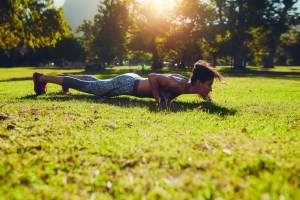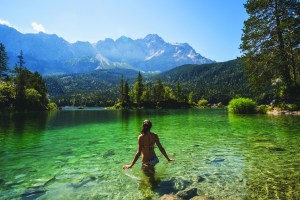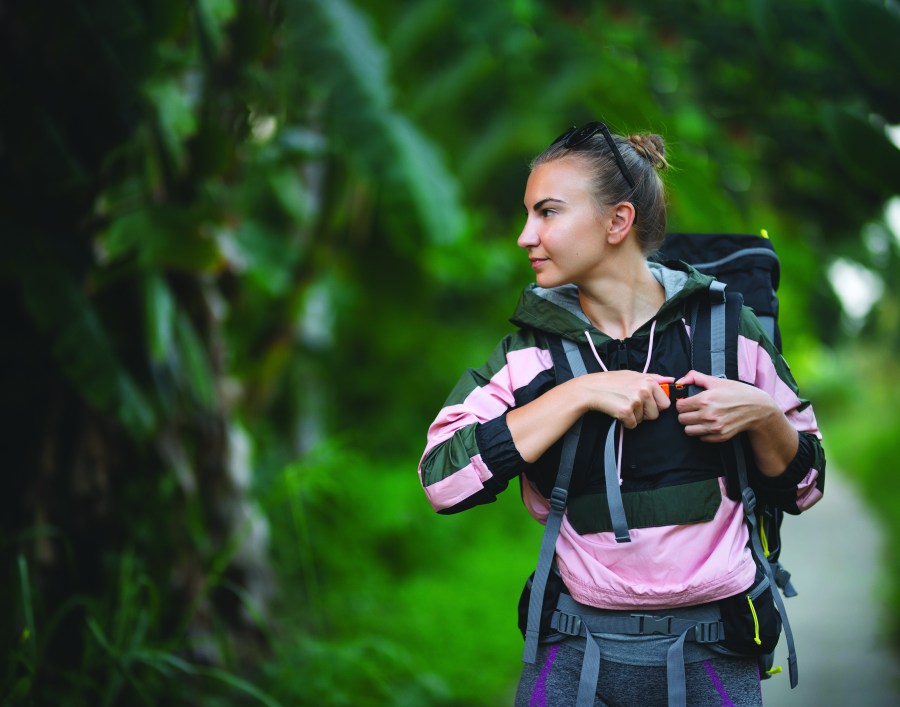Outdoor exercise in nature could put you in a better mood for the rest of the day – so head outside early to reap the rewards! Words: Lucy Miller
The early bird catches the worm, or so they say, and with the longer days and the weather heating up, now is a good time to take your workouts outside. Not only is it easier to stay consistent with morning workouts – because of the lack of social and work events planned earlier in the day – but US researchers also found adherence is often highest in the morning. Getting a dose of the ‘sunshine’ vitamin D will support healthy bones and a strong immune system, plus exercising in the open air can put you in a a great mood for the rest of the day – think reduced symptoms of anxiety, anxiousness and even loneliness, according to a study published in the journal Psychotherapy and Psychosomatics. Ready for a natural caffeine boost? Here are four outdoor workouts that will supercharge your morning.
Rucking
What is it: Not in the mood for an intense workout, but want more than walking? Try rucking. Originating from military training operations, rucking involves walking briskly while carrying a weighted backpack.
What we love is that it’s not about flashy equipment or complicated moves, it’s about putting one foot in front of the other and just getting yourself out there. It’s the kind of workout that feels familiar yet somehow refreshingly different, and it’s brilliant for clearing your mind and filling your lungs with fresh air before the day begins.
Why do it: Like walking, rucking is easy on your joints and will also deliver a surprisingly effective cardiovascular workout. The act of walking with added weight elevates your heart rate and stimulates aerobic fitness, all without the extra strain and impact associated with activities such as running. It will also challenge your glutes, legs, core and upper body, as well as your stability, balance and endurance.
How to do it: Whether it’s a hike through the woods, a stroll along the beach or a stomp around the block, rucking can be done absolutely anywhere and anyhow you want. All you need is a sturdy backpack, some weights and a route in mind. Why not start with a lighter load and gradually increase the weight as your strength and endurance improve? You can also join local walking or hiking clubs in your area and wear your rucksack for extra intensity – no one needs to know just how heavy it is, all you need to do is keep up!
Park HIIT

What is it: HIIT (high-intensity interval training) is a well-known way to boost the metabolism and, therefore, burn body fat. This is because it increases EPOC (excess post-exercise oxygen consumption, or an increased rate of oxygen intake after exercise) more than steady-state exercise, meaning you’ll burn more calories for longer after training.
Why do it: The beauty of HIIT is you can do it anywhere, which makes it a great outdoor workout. This type of training is time-efficient, and you don’t need any equipment to reap the benefits. It’s also a great way to kickstart endorphin release and avoid mid-morning or afternoon slumps. Researchers from Skidmore University found that women who did HIIT experienced a reduction in their blood pressure, whilst also lowering fat stores, especially around the midsection.
How to do it: The key is to get your heart rate up for short amounts of time, with rests in between. Pick a movement and exercise as hard as you can for a period of time (e.g. 30 seconds), then have 30 seconds of rest, and repeat. Plyometric press-ups, planks, squat jumps, star jumps and high-knees are all easy to perform outdoors and make a great HIIT session. Triceps dips, regular and lateral step-ups, and elevated planks are also great to do on a park bench. Try some hill sprints, too – just make sure you warm up effectively.
12 best outdoor fitness & adventure retreats in the UK
Sunrise yoga
What is it: Yoga in a studio is great, but taking your asanas out into nature can add extra benefits. Yoga is already a restorative form of exercise that can make you feel calmer, happier and more flexible, but rolling your mat out onto a sunny garden or beach just helps increase those effects.
Why do it: Yoga means ‘to unite’, and doing yoga first thing in the morning is a great way to help tune in to what your body needs on that particular day, while improving flexibility, balance, strength and mindfulness. Practising yoga in the morning can also help increase energy levels, improve focus and posture, and set a positive tone for the rest of the day. Australian researchers found that yoga can relieve stress and help combat depression. Plus, having your bare feet in contact with the earth is very grounding and can help you to feel stable, secure and present.
Get involved: Find a local park, or why not find a local class that takes the flow out onto a rooftop or the grass such as Park Yoga (parkyoga.co)? Search Eventbrite for local outdoor yoga classes, and if a class doesn’t suit your morning timetable, apps such glo (glo.com) or Ekhart Yoga (ekhartyoga.com) mean you can virtually take a class where and when it suits you.
Open-water swimming

What is it: Butterfly, backstroke, breaststroke, sidestroke or freestyle, there’s nothing quite like immersing yourself in an empty lake or the rolling waves of the sea! It’s free, it’s liberating and it’s a great way to wake up your body and mind first thing — no matter how early it is or how cold the water.
Why do it: Open-water morning swimming can truly take your breath away, plus you can get a real buzz from the open water and the peace and tranquillity it brings. Studies show it can help with depression, weight loss, boosting the immune system, increasing fitness and muscle strength, and adding to overall happiness. Swimming is also a great form of cardiovascular exercise that won’t put unnecessary impact through the joints. Plus, you may even catch the sunrise and some early morning rays as you get your laps in – now there’s an incentive!
Get involved: Outdoor swimming pools and open-water venues are the perfect place to dive in. Book a lido session via allthelidos.co.uk or check out The Outdoor Swimming Society’s Open Water Lake Directory (outdoorswimmingsociety.com).









